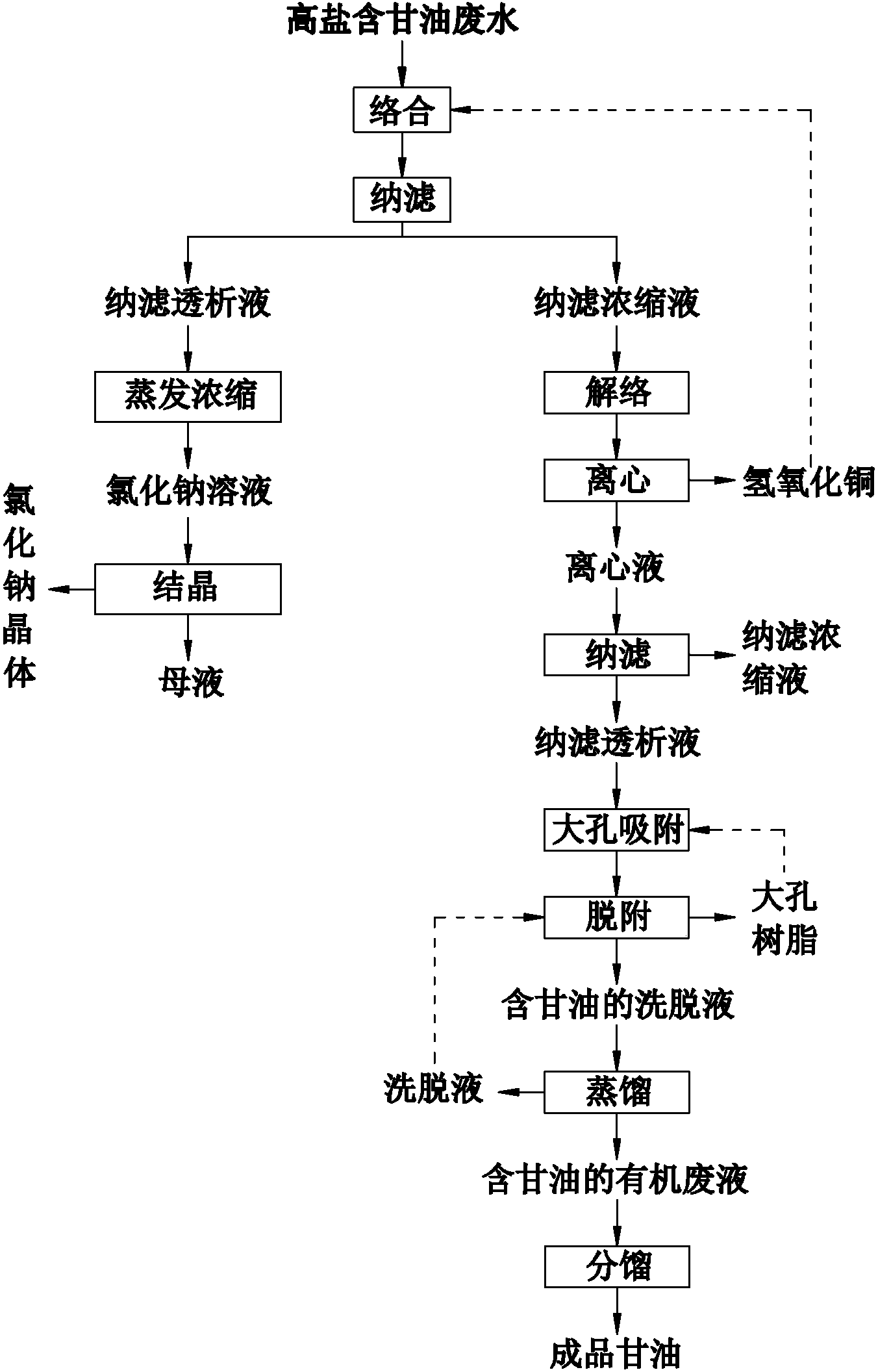Method for recovering sodium chloride and glycerol from high-salt glycerol-containing high-depth organic wastewater
A technology of organic waste water and recycling methods, applied in the preparation of organic compounds, organic chemistry, chemical instruments and methods, etc., can solve the problems of waste of resources, pollution of the environment, failure to recycle, etc., and achieve the effect of ensuring feasibility
- Summary
- Abstract
- Description
- Claims
- Application Information
AI Technical Summary
Problems solved by technology
Method used
Image
Examples
Embodiment 1
[0052] A recovery method for sodium chloride and glycerin in high-salt glycerin-containing high-depth organic wastewater:
[0053] (1) Complexation
[0054] Alkaline solution and copper sulfate are added to the high-salt glycerol-containing wastewater, so that the glycerol contained in the wastewater undergoes a complex reaction with copper ions under alkaline conditions to form glycerol copper.
[0055] The concentration of sodium chloride in the high-salt glycerin-containing wastewater is 30%, the concentration of glycerin is 2%, and the alkali solution is sodium hydroxide solution.
[0056] (2) Nanofiltration desalination (separation of glycerol and salt)
[0057] The waste water after the complexation treatment in step (1) is desalted by graded filtration through a nanofiltration membrane to obtain a nanofiltration concentrate containing copper glycerol and a nanofiltration dialysate containing sodium chloride. In order to ensure that the nanofiltration membrane is not p...
Embodiment 2
[0081] A recovery method for sodium chloride and glycerin in high-salt glycerin-containing high-depth organic wastewater:
[0082] (1) Complexation
[0083] Alkaline solution and copper sulfate are added to the high-salt glycerol-containing wastewater, so that the glycerol contained in the wastewater undergoes a complex reaction with copper ions under alkaline conditions to form glycerol copper.
[0084] The concentration of sodium chloride in the high-salt glycerol-containing wastewater is 30%, the concentration of glycerin is 12%, and the alkaline solution is sodium hydroxide solution.
[0085] (2) Nanofiltration desalination (separation of glycerol and salt)
[0086] The waste water after the complexation treatment in step (1) is desalted by graded filtration through a nanofiltration membrane to obtain a nanofiltration concentrate containing copper glycerol and a nanofiltration dialysate containing sodium chloride. In order to ensure that the nanofiltration membrane is no...
Embodiment 3
[0110] A recovery method for sodium chloride and glycerin in high-salt glycerin-containing high-depth organic wastewater.
[0111] (1) Complexation
[0112] Alkaline solution and copper sulfate are added to the high-salt glycerol-containing wastewater, so that the glycerol contained in the wastewater undergoes a complex reaction with copper ions under alkaline conditions to form glycerol copper.
[0113] The concentration of sodium chloride in the high-salt glycerol-containing wastewater is 22%, the concentration of glycerin is 12%, and the alkaline solution is sodium hydroxide solution.
[0114] (2) Nanofiltration desalination (separation of glycerol and salt)
[0115] The waste water after the complexation treatment in step (1) is desalted by graded filtration through a nanofiltration membrane to obtain a nanofiltration concentrate containing copper glycerol and a nanofiltration dialysate containing sodium chloride. In order to ensure that the nanofiltration membrane is no...
PUM
 Login to View More
Login to View More Abstract
Description
Claims
Application Information
 Login to View More
Login to View More - R&D
- Intellectual Property
- Life Sciences
- Materials
- Tech Scout
- Unparalleled Data Quality
- Higher Quality Content
- 60% Fewer Hallucinations
Browse by: Latest US Patents, China's latest patents, Technical Efficacy Thesaurus, Application Domain, Technology Topic, Popular Technical Reports.
© 2025 PatSnap. All rights reserved.Legal|Privacy policy|Modern Slavery Act Transparency Statement|Sitemap|About US| Contact US: help@patsnap.com

